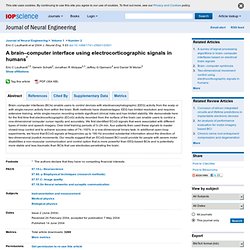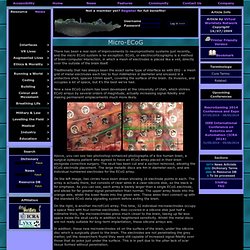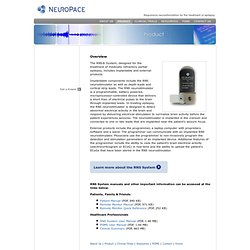

A brain–computer interface using electrocorticographic signals in humans - Abstract - Journal of Neural Engineering. Brain–computer interfaces (BCIs) enable users to control devices with electroencephalographic (EEG) activity from the scalp or with single-neuron activity from within the brain.

Both methods have disadvantages: EEG has limited resolution and requires extensive training, while single-neuron recording entails significant clinical risks and has limited stability. An Electrocorticographic Brain Interface in an Individual with Tetraplegia. Brain-computer interface (BCI) technology aims to help individuals with disability to control assistive devices and reanimate paralyzed limbs.

Our study investigated the feasibility of an electrocorticography (ECoG)-based BCI system in an individual with tetraplegia caused by C4 level spinal cord injury. ECoG signals were recorded with a high-density 32-electrode grid over the hand and arm area of the left sensorimotor cortex. The participant was able to voluntarily activate his sensorimotor cortex using attempted movements, with distinct cortical activity patterns for different segments of the upper limb. Using only brain activity, the participant achieved robust control of 3D cursor movement.
The ECoG grid was explanted 28 days post-implantation with no adverse effect. Figures. In vivo recordings of brain activity using organic transistors : Nature Communications. Transistor fabrication and characterization The fabrication and in vivo validation of PEDOT:PSS electrodes34 and the patterning of PEDOT:PSS OECTs38 were discussed in previous publications.

Here we used an adapted fabrication process that involved the deposition and patterning of parylene, Au and PEDOT:PSS films as follows: Parylene C was deposited using an SCS Labcoater 2 to a thickness of 2 μm (at which thickness parylene films are pinhole-free). These films were patterned with the aid of a 4.6-μm thick layer of AZ9260 (MicroChemicals) photoresist and reactive-ion etching by an O2 plasma (160 W, 50 sccm O2, 15 min) using an Oxford 80 plus. Metal pads and interconnects were patterned by a lift-off process. A photoresist, S1813 (Shipley), was spin-coated on the parylene film at 3,500 r.p.m., baked at 110 °C for 60 s, exposed to UV light (150 mJ cm−2) using a SUSS MJB4 contact aligner, and then developed using MF-26 developer.
Memory implants. Electrode array for monitoring and duplicating hippocampus neuron activity (credit: T.

Berger et al. /Journal of Neural Engineering) Teodore Berger, a biomedical engineer and neuroscientist at the University of Southern California in Los Angeles, envisions a day in the not too distant future when a patient with severe memory loss can get help from an electronic implant, MIT Technology Review reports. In people whose brains have suffered damage from Alzheimer’s, stroke, or injury, disrupted neuronal networks often prevent long-term memories from forming.
For more than two decades, Berger has designed silicon chips to mimic the signal processing that those neurons do when they’re functioning properly — the work that allows us to recall experiences and knowledge for more than a minute. The idea is so audacious and so far outside the mainstream of neuroscience that many of his colleagues, says Berger, think of him as being just this side of crazy.
Brain Implants Could Help Alzheimer’s and Others with Severe Memory Damage. Theodore Berger, a biomedical engineer and neuroscientist at the University of Southern California in Los Angeles, envisions a day in the not too distant future when a patient with severe memory loss can get help from an electronic implant.

In people whose brains have suffered damage from Alzheimer’s, stroke, or injury, disrupted neuronal networks often prevent long-term memories from forming. For more than two decades, Berger has designed silicon chips to mimic the signal processing that those neurons do when they’re functioning properly—the work that allows us to recall experiences and knowledge for more than a minute.
Ultimately, Berger wants to restore the ability to create long-term memories by implanting chips like these in the brain. The idea is so audacious and so far outside the mainstream of neuroscience that many of his colleagues, says Berger, think of him as being just this side of crazy. Cracking the Code But it soon became clear that the answer was extremely complex. A Future With Superhumans - a convo with PhD Daniel H. Wilson. Cognitive Enhancer: The Future of our Brains (with image) · mmichael. Micro-ECoG. Micro-ECoG There has been a real rash of improvements to neuroprosthetic systems just recently, and the micro ECoG system is no exception.

ECoG, or electrocorticography is a method of brain-computer interaction, in which a mesh of electrodes is placed like a veil, directly over the outside of the brain itself. Traditionally that has always been the exact same type of interface as with EEG - a mesh grid of metal electrodes each two to four millimetres in diameter and encased in a protective shell, spaced 10mm apart, covering the surface of the brain. Its invasive, and occupies a lot of space, but it's the best we've had. Now a new ECoG system has been developed at the University of Utah, which shrinks ECoG arrays by several orders of magnitude, actually increasing signal fidelity and making permanent emplacements much more likely.
On the left image, two circles have been drawn showing 16 electrode points in each. On the right, is another microECoG array. Overview. Overview The RNS® System, designed for the treatment of medically refractory partial epilepsy, includes implantable and external products.

Implantable components include the RNS neurostimulator as well as depth leads and cortical strip leads. The RNS neurostimulator is a programmable, battery powered, microprocessor-controlled device that delivers a short train of electrical pulses to the brain through implanted leads. In treating epilepsy, the RNS neurostimulator is designed to detect abnormal electrical activity in the brain and respond by delivering electrical stimulation to normalize brain activity before the patient experiences seizures. Organic transistors for brain mapping. This electrocorticography (ECoG) sensor array with transistors can now obtain direct, high-quality amplification and brain-signal recording (credit: Department of Bioelectronics, Ecole des Mines) To improve brain mapping, a group of French scientists have produced the world’s first biocompatible microscopic organic transistors that can amplify and record signals directly from the surface of the brain, building on prototypes developed at the Cornell NanoScale Science and Technology Facility (CNF).

This is the first in vivo use of transistor arrays to record brain activity directly on the surface of the cortex using electrocorticography (ECoG). This is a ten-fold improvement in signal/noise quality compared with current ECoG electrode technology, the scientists say. In epileptic patients, ECoG recordings help to scout brain regions responsible for seizure genesis. For patients with brain tumors, recordings help to chart the brain for tumor removal. FROM COCHLEAR IMPLANTS TO BRAIN-COMPUTER INTERFACES : Bio-Algorithms and Med-Systems BAMS.